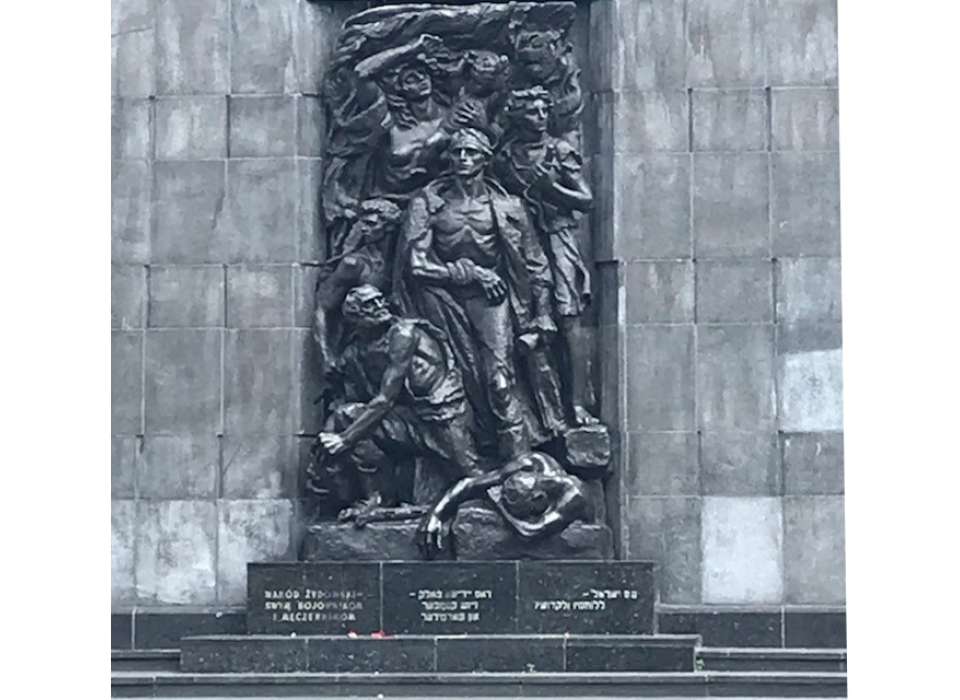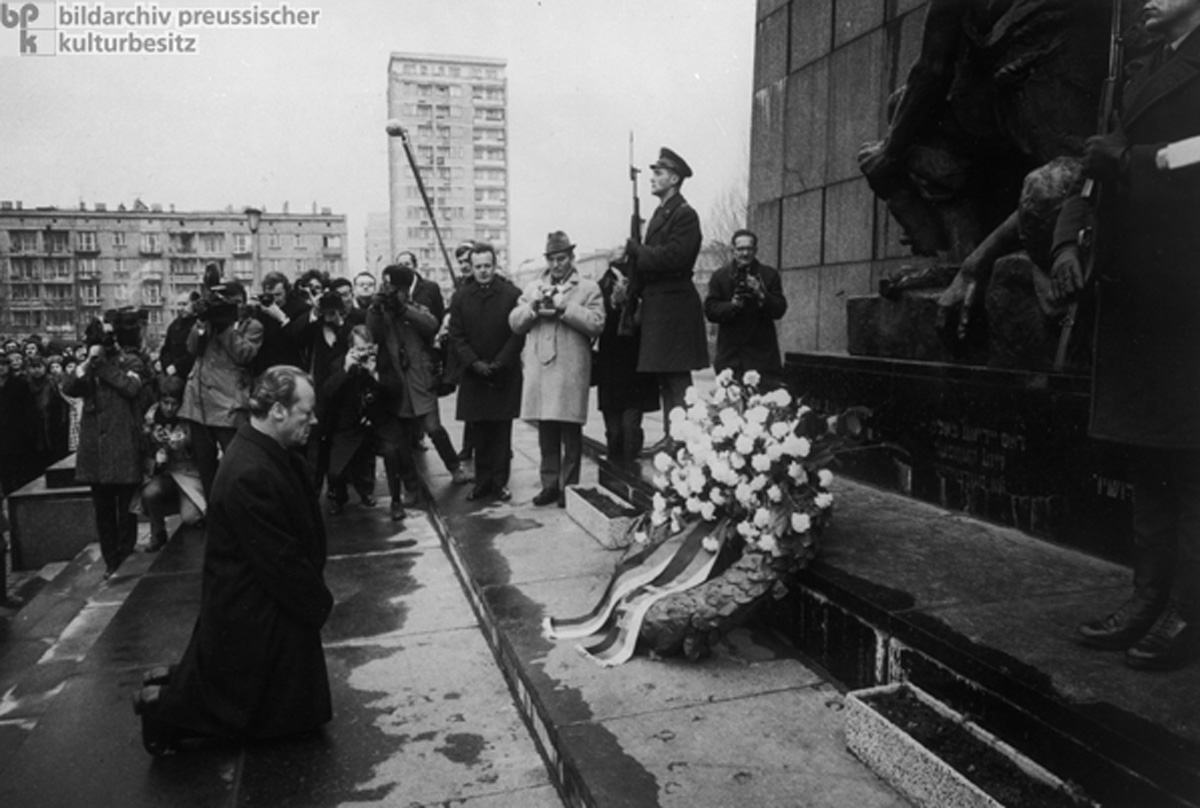Top image: Monument to the Ghetto Heroes, Warsaw, Poland, June 2022. Author’s Personal Photo.
“It is necessary and yet difficult as a German, and also as German president, to come here,” said Germany’s President Frank-Walter Steinmeier on April 19, 2023, in a ceremony commemorating the 80th anniversary of the Warsaw Ghetto Uprising. Steinmeier’s visit to Poland’s capital was historically salient for many reasons.
A guest of Poland’s President Andrzej Duda, Steinmeier’s speech followed that of Israel’s President Isaac Herzog. As the first German head of state to attend the annual commemoration, he presented before the Monument to the Ghetto Heroes, the breathtaking sculpture designed by Nathan Rapoport to immortalize the heroism and sacrifice of the resistance fighters in the Jewish Combat Organization against the Nazis in 1943. A member of the Social Democratic Party of Germany, the 67-year-old Steinmeier wore a yellow Star of David, just like those Nazis forced Jews to display on their clothing. He spoke for 16 minutes about the significance to Poland, to Israel, and, not least, to Germany of what happened in that place 80 years before. The crimes perpetrated by Germans at this site “fill me with deep shame,” he said.
Steinmeier praised the “strength” and “humanity” of Ghetto fighters like Marek Edelman and Yitzhak Zuckerman and recalled how the men and women of the Uprising “showed unimaginable courage in the darkest night.” He invoked, too, the names of Emanuel Ringelblum and Rachel Auerbach, who in the Oneg Shabbat (Joy of the Sabbath) organization secretly chronicled life in the Warsaw Ghetto. (Ringelblum perished with his family in March 1944, while Auerbach survived.)
During his remarks, the German president termed Hitler’s assault on Poland a “murderous war of annihilation,” part of a monstrous, continent wide war of conquest and extermination waged by National Socialist Germany. Ten minutes into the address, Steinmeier made a most memorable entreaty: “I stand before you today and ask for your forgiveness for the crimes the Germans began here.” Delivered with great solemnity, this moment marked yet another crucial effort by Germans to confront and atone for the barbarity of Nazism.
In a city where the SS once ruled over 400,000 Jews who were walled in and subjected to unspeakable daily humiliation, disease, hunger, and, ultimately, deportation to extermination camps, a German head of state born after World War II pleaded for forgiveness for the Third Reich’s bestial deeds and reiterated his nation’s commitment to a politics of remembrance. In his speech, Steinmeier turned to several prior moments of reconciliation in post–World War II, post-Holocaust history. Notably, he referred to the Kniefall von Warschau, or kneeling of Willy Brandt, more than five decades ago. What Steinmeier intended with the reference is absolutely worth revisiting.
On December 7, 1970, Brandt, chancellor of what was then West Germany, took an extraordinary action during his visit to Warsaw. A Social Democrat like Steinmeier, with a proud past in the anti-Nazi resistance, Brandt laid a wreath at the Monument to the Ghetto Heroes. Then he kneeled before it. This gesture alone would have cemented Brandt’s importance for posterity, capping a historic meeting with Poland’s Communist Prime Minister Józef Cyrankiewicz (himself a survivor of Auschwitz) that led to the Treaty of Warsaw. That treaty included the renunciation of the use of force and recognized the Oder–Neisse Line as Poland’s western border, attempting to resolve enormous issues traceable to Hitler’s aggression in Eastern Europe and to Allied decisions about postwar boundaries.
The treaty was a signature moment in Brandt’s Ostpolitik (policy toward Eastern Europe), intended to normalize and stabilize West Germany’s relations with the Soviet Bloc. He had already reached agreements with his Communist counterpart in East Germany and with the Soviets earlier in 1970. Speaking of his negotiations with Cyrankiewicz, Brandt declared: “We [the people of West Germany] must not forget that what the Polish nation had to suffer after 1939 was worse than anything else it had had to endure in the course of its history.” The “injustice” of the invasion and occupation of Poland by Adolf Hitler’s “criminal regime,” he insisted, had to be confronted by Germans with the further realization that “for a long time to come, names like Auschwitz will be in the minds of both nations and will remind us that hell on Earth is possible.” Without explicitly saying so, Brandt’s remarks identified two distinct crimes committed by the Nazi dictatorship against Poland: the ultra-brutal subjugation of the country and the systematic mass annihilation of Polish Jews.
By kneeling at the memorial to the Warsaw Ghetto fighters, Brandt, as the elected head of government of one of the German states succeeding the Third Reich, signified official recognition and contrition for both crimes. Though many in West Germany objected, some vehemently, to this reconciliatory gesture, Brandt stood by his action. Ultimately, his taking of the knee in a locale associated with the pain, devastation, and death of the Holocaust in Poland engendered much good will and openness.
It was Brandt’s act that people around the world have recalled as they listened to Steinmeier’s statements. A bronze plaque at Willy Brandt Square in Warsaw helps ensure the Kniefall on that December day will be remembered as a milestone in the long and vexed history and memory of Nazi criminality in Eastern Europe.
At the same time, the “unimaginable courage,” to use Steinmeier’s phrase, of the Jewish resistance in Warsaw 80 years ago is profoundly relevant today. What the women and men of the Jewish Combat Organization undertook in April and May of 1943 demonstrates how people mustered the fortitude to fight against the Nazis even in the most inconceivably desperate of circumstances.
Jason Dawsey, PhD
Jason Dawsey, PhD, is ASU WWII Studies Consultant in the Jenny Craig Institute for the Study of War and Democracy.
Cite this article:
MLA Citation:
APA Citation:
Chicago Style Citation:






![Max Fuchs, New York City cantor, sings as Rabbi Sydney [sic] Lefkowitz, Richmond, VA, conducts the first Jewish services from Germany.](/sites/default/files/styles/max_650x650/public/2025-10/image1.jpg)



